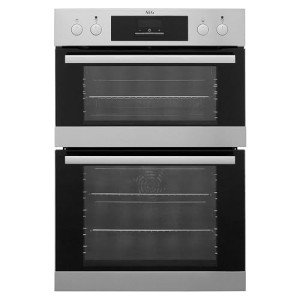5 Killer Quora Answers On Builtin Oven
페이지 정보

본문
The Comprehensive Guide to Built-In Ovens: Features, Benefits, and FAQs
Built-in ovens are a popular option for contemporary kitchens, using adaptability, performance, and a sleek style that integrates effortlessly into kitchen cabinetry. This short article will explore the numerous aspects of built-in integrated ovens uk, including their functions, benefits, installation choices, upkeep tips, and builtin oven answers to typically asked questions.

What is a Built-In Oven?
A built-in oven is created to be set up within kitchen cabinets and is available in various configurations, such as single or double ovens. Unlike freestanding ovens, built-in designs provide a streamlined appearance and provide more flexibility in kitchen design. They come in electric, gas, and steam options, dealing with a series of cooking choices.
Features of Built-In Ovens
Built-in ovens are loaded with functions that boost cooking experiences. Here are a few of the most typical features to think about:
| Feature | Description |
|---|---|
| Self-Cleaning | Lots of designs include a self-cleaning function that burns residue at high temperature levels, simplifying maintenance. |
| Convection Cooking | This function utilizes a fan to distribute hot air, cooking food more uniformly and rapidly. |
| Smart Technology | Some ovens come geared up with Wi-Fi connection, permitting users to manage the oven remotely by means of mobile phone. |
| Multiple Cooking Modes | Include choices such as baking, broiling, roasting, and air frying, providing adaptability for various meals. |
| Temperature level Probe | Keeps track of the internal temperature of food, making sure completely cooked meals whenever. |
| Streamlined Design Options | Available in different surfaces (stainless-steel, black, white) to match kitchen design. |
Benefits of Built-In Ovens
The setup of a built-in oven brings numerous advantages to any kitchen:
- Space Efficiency: Built-in ovens maximize kitchen area, supplying a clean and organized appearance without sacrificing performance.
- Improved Cooking Performance: With advanced functions like convection cooking and exact temperature controls, built-in ovens frequently surpass traditional designs.
- Design Flexibility: These ovens can be installed at eye level, allowing for easy gain access to without bending down, which can be especially beneficial for individuals with physical restrictions.
- Improved Resale Value: A well-designed kitchen with premium built-in appliances might interest prospective purchasers, enhancing overall residential or commercial property value.
- Customization Options: Many brands provide adjustable styles that fit the specific measurements and visual of private kitchens.
Installation Options
When choosing a built-in oven, understanding the setup alternatives is crucial. Here are the most common setups:
Single built in ovens and microwaves-In Oven: Ideal for smaller sized cooking areas, these systems use enough area to prepare a range of dishes all at once, best for everyday cooking.
Double Built-In Oven: Best fit for passionate cooks and large households, double ovens enable for simultaneous cooking at two different temperatures, ideal for meals that need diverse cooking techniques.
Combination Steam and Oven: A hybrid service that combines the benefits of standard baking with steam cooking. This choice is excellent for keeping wetness in foods, making it ideal for baking bread or roasting meats.
Upkeep Tips for Built-In Ovens
Preserving a built-in oven is vital for its durability and optimal efficiency. Here are some useful maintenance pointers:
Regular Cleaning: Use the self-cleaning feature when needed, and wipe down the outside and interior surfaces frequently to avoid grease accumulation.
Check the Seals: Inspect the oven door seals for any wear or damage to guarantee correct insulation and cooking performance.
Temperature level Calibration: Occasionally check the temperature level accuracy utilizing an oven thermometer, especially if cooking times appear longer than usual.
Ventilation: Ensure appropriate ventilation around the oven to avoid overheating, particularly for built-in models that might be surrounded by cabinets.
Frequently Asked Questions About Built-In Ovens
1. Are built-in ovens more pricey than freestanding designs?Yes, built-in integrated ovens tend to be more expensive due to their design, setup requirements, and extra features. However, their advantages can validate the expense in the long run.
2. Can you install a built-in oven yourself?While some handy people might try to set up a built-in oven, it is suggested to hire an expert to guarantee proper installation, ventilation, and security standards.
3. What is the typical lifespan of a built-in oven?The normal life expectancy of a built-in builtin Oven is around 10 to 15 years, depending upon use and maintenance. Regular care can assist extend its durability.
4. Are built-in ovens energy effective?Many contemporary built-in ovens are developed with energy efficiency in mind, integrating features like insulation and accurate temperature level controls that may minimize energy consumption compared to older designs.
5. Can a built-in oven be repaired if it breaks?Yes, built-in ovens can frequently be fixed. It is recommended to call a qualified service technician for medical diagnoses and repair work to guarantee safety and compliance with warranty agreements.
Built-in ovens are an exceptional addition to any modern-day kitchen, supplying a mix of design, performance, and advanced cooking features. With the right knowledge about their features, benefits, and upkeep, house owners can make informed options to improve their cooking experiences. As kitchen style trends continue to evolve, the built-in oven remains a staple for those seeking to blend aesthetic appeals with performance in their cooking spaces.

- 이전글See What Dual Fuel Cooker Range Tricks The Celebs Are Utilizing 25.05.20
- 다음글15 Things You Didn't Know About L Shaped Bunk Bed With Slide 25.05.20
댓글목록
등록된 댓글이 없습니다.



